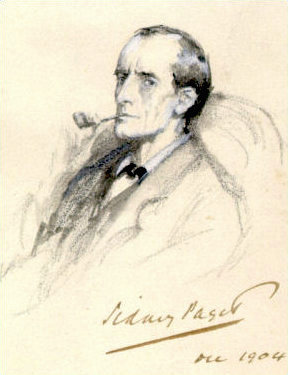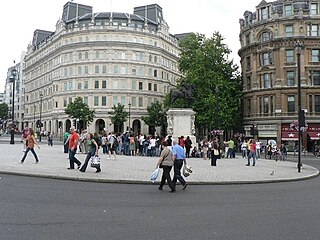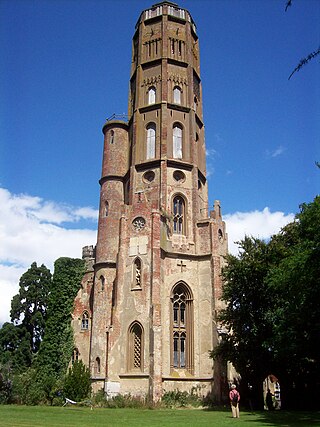
Sherlock Holmes is a fictional detective created by British author Arthur Conan Doyle. Referring to himself as a "consulting detective" in the stories, Holmes is known for his proficiency with observation, deduction, forensic science and logical reasoning that borders on the fantastic, which he employs when investigating cases for a wide variety of clients, including Scotland Yard.

Charing Cross is a junction in Westminster, London, England, where six routes meet. Since the early 19th century, Charing Cross has been the notional "centre of London" and is now the point from which distances from London are measured. Clockwise from north, the routes that meet at Charing Cross are: the east side of Trafalgar Square leading to St Martin's Place and then Charing Cross Road; the Strand leading to the City; Northumberland Avenue leading to the Thames Embankment; Whitehall leading to Parliament Square; The Mall leading to Admiralty Arch and Buckingham Palace; and two short roads leading to Pall Mall.

Trafalgar Square is a public square in the City of Westminster, Central London, established in the early 19th century around the area formerly known as Charing Cross. The square's name commemorates the Battle of Trafalgar, the British naval victory in the Napoleonic Wars over France and Spain that took place on 21 October 1805 off the coast of Cape Trafalgar.

Charing Cross is a London Underground station at Charing Cross in the City of Westminster. The station is served by the Bakerloo and Northern lines and provides an interchange with Charing Cross mainline station. On the Bakerloo line it is between Embankment and Piccadilly Circus stations and on the Northern line it is between Embankment and Leicester Square stations. The station is in fare zone 1.

George Edward Challenger is a fictional character in a series of fantasy and science fiction stories by Sir Arthur Conan Doyle. Unlike Conan Doyle's self-controlled, analytical character, Sherlock Holmes, Professor Challenger is an aggressive, hot-tempered, dominating figure.

221B Baker Street is the London address of the fictional detective Sherlock Holmes, created by author Sir Arthur Conan Doyle. In the United Kingdom, postal addresses with a number followed by a letter may indicate a separate address within a larger, often residential building. Baker Street in the late 19th century was a high-class residential district, and Holmes's apartment would probably have been part of a Georgian terrace.

Pall Mall is a street in the St James's area of the City of Westminster, Central London. It connects St James's Street to Trafalgar Square and is a section of the regional A4 road. The street's name is derived from pall-mall, a ball game played there during the 17th century, which in turn is derived from the Italian pallamaglio, literally "ball-mallet".

George Ledwell Taylor was an architect and landowner who lived in London.

The Baker Street Irregulars is an organization of Sherlock Holmes enthusiasts founded in 1934 by Christopher Morley. As of 2015, the nonprofit organization had about 300 members worldwide.

Air Commandant Dame Lena Annette Jean Conan Doyle, Lady Bromet, was a British Women's Royal Air Force officer.
Sherlockiana is a term which has been used to refer to various categories of materials and content related to the fictional detective Sherlock Holmes, created by Arthur Conan Doyle. The word "Sherlockiana" has been used for literary studies and scholarship concerning Sherlock Holmes, Sherlock Holmes pastiches in print and other media such as films, and memorabilia associated with Sherlock Holmes. Sherlockiana may be defined as "anything about, inspired by, or tangentially concerning" Sherlock Holmes.

Northumberland Avenue is a street in the City of Westminster, Central London, running from Trafalgar Square in the west to the Thames Embankment in the east. The road was built on the site of Northumberland House, the London home of the Percy family, the Dukes of Northumberland between 1874 and 1876, and on part of the parallel Northumberland Street.

Traditionally, the canon of Sherlock Holmes consists of the 56 short stories and four novels written by Sir Arthur Conan Doyle. In this context, the term "canon" is an attempt to distinguish between Doyle's original works and subsequent works by other authors using the same characters.

Sir Arthur Ignatius Conan Doyle was a British writer and physician. He created the character Sherlock Holmes in 1887 for A Study in Scarlet, the first of four novels and fifty-six short stories about Holmes and Dr. Watson. The Sherlock Holmes stories are milestones in the field of crime fiction.

The Sherlock Holmes is a Victorian era themed public house in Northumberland Street near Charing Cross railway station and Trafalgar Square which contains a large collection of memorabilia related to the fictional detective Sherlock Holmes. The original collection was put together for display in Baker Street in London during the Festival of Britain in 1951.
Atkinson Morley was a British hotelier. He was responsible for Morley's Hotel, designed by George Ledwell Taylor and which occupied the entire eastern side of London's Trafalgar Square, from 1832, until it was demolished in 1936 and replaced with South Africa House.

Undershaw is a former residence of the author Sir Arthur Conan Doyle, the creator of Sherlock Holmes. The house was built for Doyle at his order to accommodate his wife's health requirements, and is where he lived with his family from 1897 to 1907. Undershaw is where Doyle wrote many of his works, including The Hound of the Baskervilles.

The fourth plinth is the northwest plinth in Trafalgar Square in central London. It was originally intended to hold an equestrian statue of William IV, but remained bare due to insufficient funds. For over 150 years the fate of the plinth was debated; in 1998, the Royal Society for the encouragement of Arts, Manufactures and Commerce (RSA) commissioned three contemporary sculptures to be displayed temporarily on the plinth. Shortly afterwards, Chris Smith, Secretary of State for Culture, Media and Sport, commissioned Sir John Mortimer to seek opinions from public art commissioners, critics and members of the public as to the future of the plinth.
Sherlock Holmes fandom is an international, informal community of fans of the stories by Arthur Conan Doyle featuring the fictional detective Sherlock Holmes. The fans are known as Sherlockians or Holmesians. Many fans of Sherlock Holmes participate in societies around the world, and engage in a variety of activities such as discussion, tourism, and collecting.
David Hatton Morley was a British coffee house keeper, and owned the British Coffee House at 27 Cockspur Street, London.

















